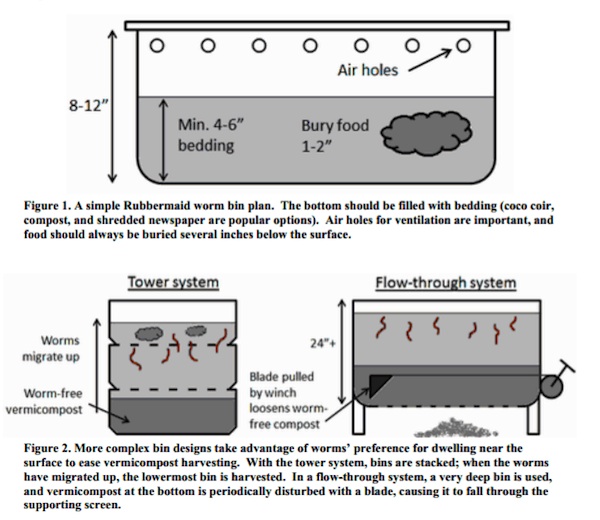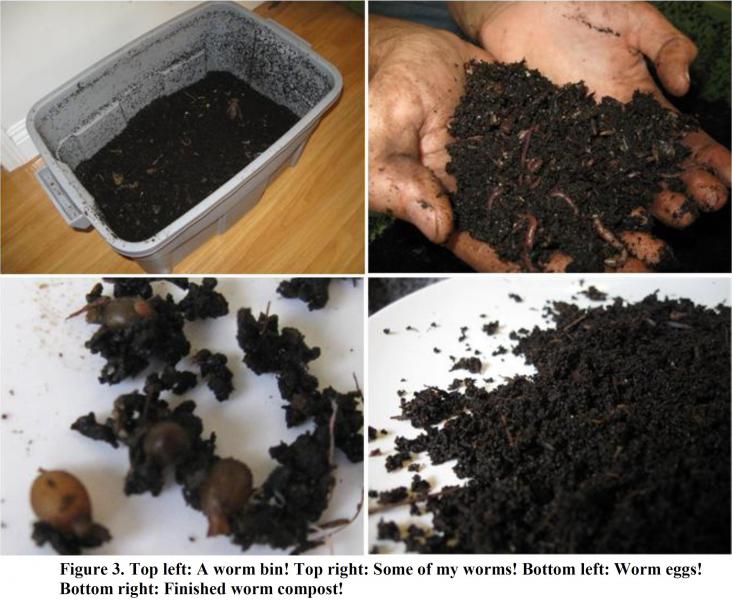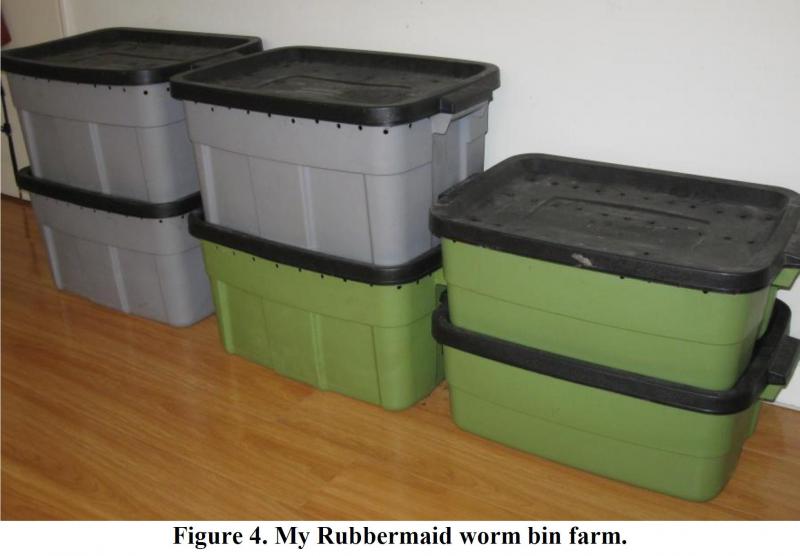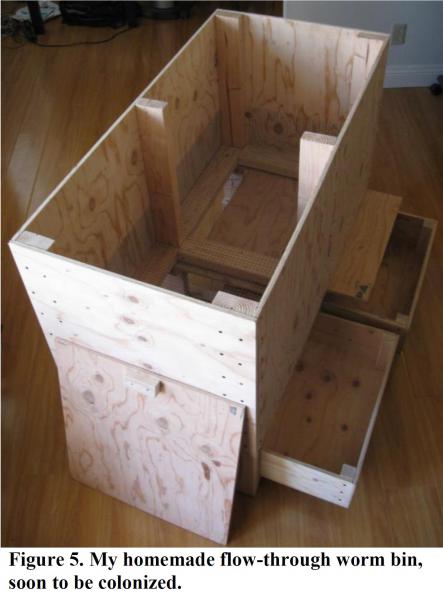|
 My one- My one-
bedroom apartment is home to a thriving herd of thousands of wriggling worms, ranging freely through a colony of bins. Worms are not demanding houseguests. Some soil to bed down in, a container to live in, and some food scraps a happy worm make. Taking whatever kitchen waste I produce — coffee grounds, melon peels, soiled paper, you name it — and these little worms transform it into a nutrient-rich compost.
A few short months ago, I came across the notion of worm composting, a.k.a. vermicomposting, which can be done indoors, as a way for urban dwellers to reduce their environmental impact.
A number of commercial worm bins are available, but after much deliberation and scouring of the Internet, I opted for the
popular and inexpensive Rubbermaid route: I secured a 14-gallon plastic bin from the local hardware store, filled it with damp coconut coir, drilled air-holes in the sides and lid, and ordered some 2,000 Eisenia fetida red wriggler worms online. Yes, gentle reader, live worms pass through the U.S. Postal Service with some regularity.
A worm's lifestyle
Worms are afraid of the light and when introduced to a new home quickly burrow in. Unlike many earthworms, red wrigglers stay near the soil surface to feed on rotting debris, and so they are perfectly happy living in a shallow bin.
After a while, a little ecosystem started to develop in the bins. Microorganisms that break organic matter down began to take hold, and everything started to decay faster. The worms do most of the heavy lifting, eating the bulk of the food as it decays. Word of the free lunch got around, and soon springtails, mites, and roly-polies (all harmless) were sharing the bin. One day, much to my delight, I discovered little yellow worm cocoons (eggs). Soon, tiny baby worms could be seen frolicking amongst the discarded banana peels.

And as the worms made more and more baby worms, I expanded my Rubbermaid Empire. Probably like most people, I never before gave much thought to where the food I threw out ended up or the impact it had when it was transmuted into trash. However, food makes up the largest single component of residential waste, and the Environmental Protection Agency estimates that more than 36 million tons of food enter the U.S. municipal waste stream yearly, with less than 4% recovered for composting [1].
Once entombed in a landfill, anaerobic breakdown of food rapidly generates large amounts of methane gas, a potent greenhouse gas that is up to 105 times more powerful than carbon dioxide in the 20-year time-frame [2]. Landfills are significant contributors to global warming, largely thanks to the food we through away. And all this food represents a rather staggering quantity of valuable organic matter that could be composted and returned to the land, improving soil quality and at least partially offsetting the need for chemical fertilizers. More cities are starting to compost food waste, but what is the unfortunate denizen of a less enlightened municipality to do? If you have a yard, traditional composting is an option. But if not? Enter the urban worm.
Why the soil is so good
The (odorless) vermicompost that is produced (a combination of worm poop and humic substances) is highly valued as a soil amendment. It's rich in microorganisms, and processing by worms appears to increase nutrient availability to plants. Various studies have found vermicompost to promote plant germination, seedling growth, and flowering, improve crop growth and yield, enhance soil microbial activity, especially that of beneficial mycorrhiza, suppress plant diseases and pests, and improve soil structure and moisture-retention [3, 4, 5].

The beneficial effects of vermicompost appear to be largely mediated by the rich microbial communities they harbor. Furthermore, worms may be used in bioremediation of heavy metal contaminated soils, and vermicompost may be used to filter heavy metals from wastewater [6, 7].
Vermicomposting has been growing in popularity over the last couple decades, and not only for small-scale home composting. Several companies produce large-scale worm composting systems for institutional use. Santa Monica College, for example, has operated a roughly 600,000 worm flow-through worm system since 2001.
There’s a certain magic about having a living ecosystem at work in your bedroom in the heart of the city, and it feels good to take what would have been rubbish at a dump and support life with it instead. Sometimes, if you listen closely you can hear the worms working away: a gentle crackling like that of Rice Krispies which is actually rather comforting.
I would not have expected it, but my worms have opened other doors for me. Once I started producing fertilizer, I figured I’d need somewhere to put it, and so I started a plot at the local community garden, and I’ve become much more interested in general in “closing the loop” with respect to material and nutrient cycles.
Since I decided I wanted to trade up from plastic bins, but still do-it-myself, I’m developing an interest in tools. I’ve just put the finishing touches on a homemade 120-gallon capacity flow-through worm bin, and soon some lucky worms will be moving up from their humble plastic beginnings into the cosmopolitan splendor of a new wooden abode.

Of course, most people to whom I mention my particular brand of urban livestock react with, at best, puzzlement. But waste is an integral part of life. We generally ignore it as long as someone is at hand to haul it away - out of sight, out of mind. Since I started my worm box, I’ve become much more mindful of my own wasteful habits.
Also, with the worms handling so much of my waste, it’s really surprising how rarely I have to take the trash out these days. While source reduction is by far the preferred method to deal with food waste (and waste in general), some is inevitable, and we can either treat it as the valuable resource it is, or we can bury it in landfills. Worm composting is a wonderful thing, because anyone can do it, wherever you live, and it may just be your gateway drug to a more environmental mindset. All you need is a bin.
How to make your own worm bin
Figure 1. A simple Rubbermaid worm bin plan. The bottom should be filled with bedding (coco coir, compost, and shredded newspaper are popular options). Air holes for ventilation are important, and food should always be buried several inches below the surface.
Figure 2. More complex bin designs take advantage of worms’ preference for dwelling near the surface to ease vermicompost harvesting. With the tower system, bins are stacked; when the worms have migrated up, the lowermost bin is harvested. In a flow-through system, a very deep bin is used, and vermicompost at the bottom is periodically disturbed with a blade, causing it to fall through the supporting screen.
Figure 3. From top left: (1) A worm bin! (2) Some of my worms! (3, bottom left) Worm eggs! (4) Finished worm compost!
Figure 4. My Rubbermaid worm bin farm.
Figure 5. My homemade flow-through worm bin, soon to be colonized.
"How to set up a worm bin" instruction sheet - DOWNLOAD PDF (1 page, 88 KB)
References where you can find out more about worm composting:
[1] EPA. Municipal Solid Waste Generation, Recycling, and Disposal in the United States: Facts and Figures for 2011. http://www.epa.gov/osw/nonhaz/municipal/msw99.htm.
[2] Shindell, D. T., Faluvegi, G., Koch, D. M., Schmidt, G. A., Unger, N., & Bauer, S. E. (2009). Improved attribution of climate forcing to emissions. Science, 326(5953), 716-718.
[3] Tomati, U., Grappelli, A., & Galli, E. (1988). The hormone-like effect of earthworm casts on plant growth. Biology and Fertility of Soils, 5(4), 288-294.
[4] Arancon, N. Q., Edwards, C. A., Bierman, P., Welch, C., & Metzger, J. D. (2004). Influences of vermicomposts on field strawberries: 1. Effects on growth and yields. Bioresource Technology, 93(2), 145-153.
[5] Arancon, N. Q., Galvis, P. A., & Edwards, C. A. (2005). Suppression of insect pest populations and damage to plants by vermicomposts. Bioresource technology, 96(10), 1137-1142.
[6] Parra, L. M. M., Vazquez, C., Macchi H, L. M., Urdaneta, C., Amaya, J., Cortez, J., & Matute, S. (2010). Use of earthworms (Eisenia fetida) and vermicompost in the processing and safe management of hazardous solid and liquid wastes with high metal contents. International Journal of Global Environmental Issues, 10(3), 214-224.
[7] Mudhoo, A., Garg, V. K., & Wang, S. (2012). Removal of heavy metals by biosorption. Environmental Chemistry Letters, 10(2), 109-117.
|


 My one-
My one-
Kathryn Kassem
August 2, 2013, 11:02 pm